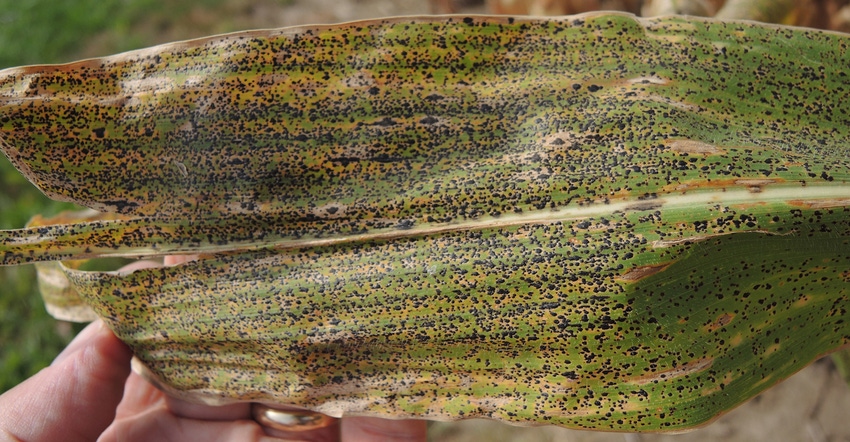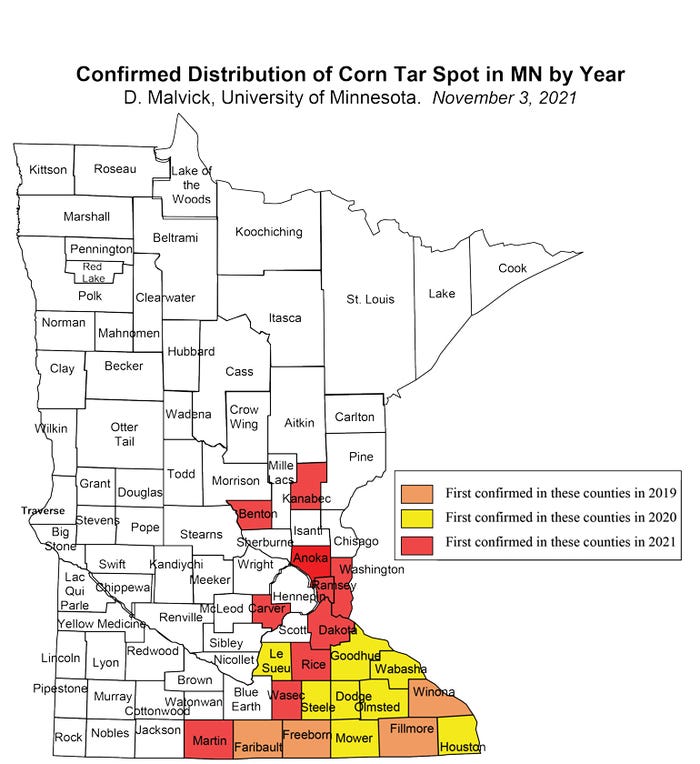
Tar spot in corn was confirmed in 11 more Minnesota counties in 2021.
The fungal disease, first reported in 2019 and confirmed in four southeastern counties, spread in distribution and severity this past growing season. Currently, cornfields in 23 counties were confirmed to have tar spot.
Dean Malvick, University of Minnesota Extension plant pathologist, noted in an Oct. 28 Crop News blog that tar spot, with its spread west and north from its initial southeastern location, may pose a risk to more areas in the future.
Malvick says d the first report he received of tar spot was during the last week of July in Fillmore County. Tar spot was widespread in fields and most severe in southeast Minnesota, where the disease was established in previous years, and rains were more common this summer than in other areas, he notes.
“Even in southeast Minnesota, tar spot was at low levels in most fields until late August and September,” he says. “It had no effect on corn yields. However, yield loss due to tar spot was likely in some fields.” He suspects that tar spot probably spread to other counties where it was not detected or was unreported.

WHERE IT’S HEADING: The distribution map for tar spot, which started in southeastern Minnesota, shows spread of the disease to the north and west. Most of the counties with new findings of tar spot had very low levels of disease when it was observed in September and October. Tar spot probably started in many of those fields in early to mid-September following the rains.

Corn tar spot, caused by the fungus Phyllachora maydis, infects and damages leaves. It produces small, raised, irregularly shaped black structures on leaves. The black structures are firm, appear mostly smooth on the surface, and do not rub off or break open.
The fungus can cause significant yield loss, depending on weather, severity and timing of disease development. Risk of disease is highest in areas with frequent rains where the disease has previously occurred.
How tar spot spreads
Tar spot spreading via wind seems likely, according to Malvick, but scientists don’t know yet how far it can spread this way.
“For example, I found tar spot in September in late-planted corn plots on the St. Paul campus,” he says. “As most of you know, there are no nearby cornfields. Did it travel via wind more than 10 miles from the nearest large cornfields, or did it make short jumps on garden plots across the suburbs and city to campus?”
Tar spot also likely spreads by infested residue, he adds.
Malvick says the disease did not affect yield outside of southeast Minnesota.
“This is likely due to late development of disease, possibly due to dry conditions and the lack of local inoculum to start the disease,” he says.
Given that the fungal disease is established in the state, Malvick says it may pose an increased risk to corn crops. Tar spot spread in other states and developed to severe levels in many areas, he adds.
A map with the known distribution of tar spot in the U.S. is available from corn.ipmpipe.org.
Online resources about tar spot can be found at:
Tar spot preface and introduction.
How tar spot of corn impacted hybrid yields during the 2018 Midwest epidemic.
Source: University of Minnesota Extension, which is solely responsible for the information provided and is wholly owned by the source. Informa Business Media and all of its subsidiaries are not responsible for any of the content contained in this information asset.
About the Author(s)
You May Also Like






